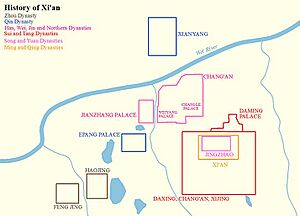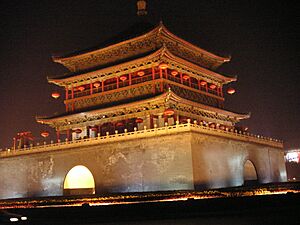History of Xi'an facts for kids
Xi'an is a very old city in China, with a history that goes back more than 6,000 years! It has been a really important place for many powerful Chinese dynasties. For a long time, it was known as Chang'an, which means "Perpetual Peace" or "Eternal Peace." Let's explore some of the amazing things that happened in this historic city.
Ancient Beginnings: Early Capitals
The history of Xi'an begins even before it was called Xi'an. Around 1100 BC, the Zhou dynasty set up its capital cities, Feng and Hao, near where Xi'an is today. However, due to some political problems, they moved their capital to another city in 770 BC.
Later, around 350 BC, the state of Qin made Xianyang its capital. This city was just north of modern Xi'an, across the Wei River. When the Qin dynasty finally united all of China in 221 BC, Xianyang became the capital of the first Chinese empire. Sadly, it was burned down at the end of the dynasty.
The Han Dynasty: A New Era
In 202 BC, a new leader named Liu Bang started the Han dynasty. He chose a place called Chang'an as his capital. This is often seen as the official start of Xi'an as a major city. Liu Bang built his first palace, Changle Palace, near the ruins of the old Qin capital.
Two years later, in 200 BC, Emperor Liu Bang built an even bigger palace called Weiyang Palace in Chang'an. The city grew quickly, and in 194 BC, people started building a huge city wall around Chang'an. This wall was finished in 190 AD. It was about 25.7 kilometers (16 miles) long and very thick at the bottom, making the city inside about 36 square kilometers (14 square miles).
In 190 AD, a powerful military leader named Dong Zhuo moved the emperor's court from another city to Chang'an. He did this to avoid other powerful leaders who were against him.
The Golden Age: Sui and Tang Dynasties
In 582 AD, the Sui dynasty emperor decided to build a brand new capital city southeast of the old Han capital. He called it Daxing, which means "great excitement." This new city was huge! It had three main parts: the palace for the emperor, the imperial city for government buildings, and a large area for regular people. The entire city inside its walls was about 84 square kilometers (32 square miles). The main street, Zhuque Avenue, was incredibly wide, about 155 meters (508 feet) across! At that time, it was the largest city in the world.
When the Tang dynasty took over, they renamed the city Chang'an, meaning "Perpetual Peace." This period was a golden age for the city.
In the 7th century, a famous Buddhist monk named Xuanzang returned from India with many important Buddhist scriptures. He set up a large center in Chang'an to translate these scriptures into Chinese. To store these precious translations, the Great Wild Goose Pagoda was built in 652 AD. It was 64 meters (210 feet) tall.
Later, in 707 AD, the Small Wild Goose Pagoda was also built. It was originally 45 meters (148 feet) tall, but an earthquake in 1556 made it a bit shorter, to 43.4 meters (142 feet).
In 781 AD, a special stone monument called the Nestorian Stele was put up in Chang'an. It tells the story of how Christianity came to China and grew there for about 150 years during the Tang dynasty.
Later Years and Modern History
The end of the Tang dynasty in 904 AD brought a lot of destruction to Chang'an. Many people were forced to move to a new capital city. Only a small part of the city remained occupied after this time.
In the 13th century, the famous traveler Marco Polo visited Xi'an. He wrote that the people there had many different beliefs.
In 1370, during the Ming dynasty, a new city wall was built around a much smaller Xi'an. This wall was about 11.9 kilometers (7.4 miles) around, 12 meters (39 feet) high, and very thick at the base. This wall is still standing today and is a famous landmark!
In 1936, Xi'an became famous for an event called the Xi'an Incident. This happened during the Second Sino-Japanese War. It led to a truce between the Communist Party of China and the Kuomintang (the Nationalist Party). This truce allowed both groups to work together to fight against Japan.
Finally, on May 20, 1949, the People's Liberation Army took control of Xi'an from the Kuomintang, marking a new chapter in the city's long history.



